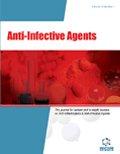Abstract
Introduction: An attractive antibiotic-adjuvant strategy consisting of the design and synthesis of polyaminoisoprenyl molecules able to restore the antibiotic activity of tetracycline antibiotics against resistant Pseudomonas aeruginosa bacterial strains has been developed.
Methods: These chemo-sensitizers are readily prepared from geraniol and farnesol in an efficient two steps synthesis with good to moderate yields varying from 38 to 64% and leading to a significant decrease in antibiotic resistance.
Results: Thus, the influence of the nature of the tetracycline antibiotic used as well as the structure of the polyaminoisoprenyl derivatives involved in the outcome of the antibiotic-adjuvant combination against P. aeruginosa resistance to tetracyclines were investigated.
Conclusion: Additionally, our data suggested that their mechanism of action is closely associated with the increase of the outer-membrane permeability.
Keywords: Polyaminoisoprenyl derivatives, antibiotic adjuvants, polyamines, Pseudomonas aeruginosa, tetracycline antibiotic.
Graphical Abstract
Anti-Infective Agents
Title:Antibiotic Adjuvants to Rescue Pseudomonas aeruginosa from Tetracycline Antibiotics Resistance
Volume: 19 Issue: 1
Author(s): Azza Troudi, Hana Douafer, Jean-Michel Bolla, Naouel Klibi and Jean M. Brunel*
Affiliation:
- Aix Marseille Univ, INSERM, SSA, MCT, 13385 Marseille,France
Keywords: Polyaminoisoprenyl derivatives, antibiotic adjuvants, polyamines, Pseudomonas aeruginosa, tetracycline antibiotic.
Abstract:
Introduction: An attractive antibiotic-adjuvant strategy consisting of the design and synthesis of polyaminoisoprenyl molecules able to restore the antibiotic activity of tetracycline antibiotics against resistant Pseudomonas aeruginosa bacterial strains has been developed.
Methods: These chemo-sensitizers are readily prepared from geraniol and farnesol in an efficient two steps synthesis with good to moderate yields varying from 38 to 64% and leading to a significant decrease in antibiotic resistance.
Results: Thus, the influence of the nature of the tetracycline antibiotic used as well as the structure of the polyaminoisoprenyl derivatives involved in the outcome of the antibiotic-adjuvant combination against P. aeruginosa resistance to tetracyclines were investigated.
Conclusion: Additionally, our data suggested that their mechanism of action is closely associated with the increase of the outer-membrane permeability.
Export Options
About this article
Cite this article as:
Troudi Azza , Douafer Hana , Bolla Jean-Michel , Klibi Naouel and Brunel M. Jean *, Antibiotic Adjuvants to Rescue Pseudomonas aeruginosa from Tetracycline Antibiotics Resistance, Anti-Infective Agents 2021; 19 (1) . https://dx.doi.org/10.2174/2211352518999200629164624
| DOI https://dx.doi.org/10.2174/2211352518999200629164624 |
Print ISSN 2211-3525 |
| Publisher Name Bentham Science Publisher |
Online ISSN 2211-3533 |
 21
21 1
1
- Author Guidelines
- Bentham Author Support Services (BASS)
- Graphical Abstracts
- Fabricating and Stating False Information
- Research Misconduct
- Post Publication Discussions and Corrections
- Publishing Ethics and Rectitude
- Increase Visibility of Your Article
- Archiving Policies
- Peer Review Workflow
- Order Your Article Before Print
- Promote Your Article
- Manuscript Transfer Facility
- Editorial Policies
- Allegations from Whistleblowers
- Announcements



























